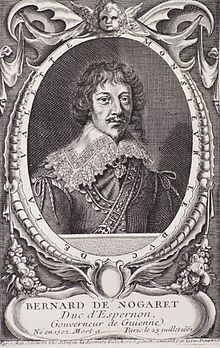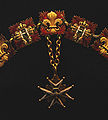Bernard de Nogaret de La Valette d'Épernon
Bernard de Nogaret de La Valette d'Épernon (* 1592 in Angoulême ; † July 25, 1661 in Paris ), duc d'Épernon - also: d'Espernon and von La Valette , was an aristocrat and military commander in the kingdom of France in the 17th century . Century.
Life
He was the second son of Jean Louis de Nogaret de La Valette and Marguerite de Foix-Candale, granddaughter of Anne de Montmorency . Bernard had Mr du Plessis as tutors for “wisdom” and Mr de la Brou for the arms trade. He traveled to Italy and Germany, where he met Emperor Rudolf II . He was involved when in March 1622 Villebois-Lavalette , fief of his father, was raised to duchy and peerage.
At the age of 18 he was appointed Colonel général over the "Bandes françaises" in 1610 , thus succeeding his father. He held this (provisional) title during the last actions against the Huguenots : the siege of Saint-Jean-d'Angély and the siege of Royan (1621), the disarming of the Protestants in Languedoc (1629), the attack on the pass near Susa (1629), in Picardy (1636) and in Guyenne .
In 1637 he suppressed the croquant revolt .
From 1635 to 1638 he was fighting Spain when he was able to occupy the Labord , but suffered a crushing defeat in the Battle of Fontarrabie in 1638. Thereupon he was sentenced to death, but was able to get to England in safety. Here he remained in exile for five years. After the death of Louis XIII in 1643 and that of his father a year earlier, which earned him the inheritance of the title “Duc d'Épernon”, he returned to France. The judgment of 1638 had been overturned by the parliament in Paris with the help of Cardinal Mazarin .
In 1643 he was then also de jure Colonel General of the Infantry.
He became governor of the Guyenne, which he remained until his death. From 1651 to 1659 he was also governor of Burgundy.
During the uprising of the Fronde he was tasked with persecuting their members in the Parliament of Bordeaux . In the autumn of 1650 he destroyed Langoiran Castle in the Bordelais , which was the ancestral seat of the President of Parliament, Guillaume d'Affis. He was little impressed by the evil rumors that his enemies had circulated about him and, like his father, was distinguished by his greed, brutality and vices.
After making himself extremely unpopular in Gascony , he returned to Paris, where he died in 1661. In his will, he bequeathed his possessions to the Foix-Candale family.
Reliable sources say that in 1627 he poisoned his wife Gabrielle, legitimate daughter of Henri IV and the Marquise de Verneuil . With her he had a son, Louis-Charles de Nogaret de Foix, duc de Candale, and a daughter, Anne-Louise-Christine de Foix de La Valette d'Épernon. He publicly cheated on his second wife, Marie du Cambout (niece of Cardinal Richelieu ) with the commoner Ninon de Lartigue, who completely ruled him and who bore him an unknown number of children.
He was a sponsor of Charles Dufresne's theater company, which later became the Molière Theater .
All titles
Monseigneur Bernard de Foix de La Valette, duc d'Espernon et pair de France, colonel général de France, prince Captal de Buch , sire de L'Esparre, chevalier des ordres du roy et de la Jarretière, governor and lieutenant-général pour Sa Majesté en ses Pays de Bourgogne et Bresse etc.
He was also Duc de La Valette and Peer of France between 1622 and 1649 and another three years from 1658, after the death of his son Louis-Charles, until his own demise.
His older brother Henry de Nogaret de La Valette was heir to the Duchy of Foix-Candale. He was also blamed for the disaster at Fontarrabie.
Footnotes and individual references
- ^ Archives Historiques de Saintonge et d'Aunis. Volume XXXVII: Lettres de Samuel Robert. Alphonse Picard, Paris 1907 (on Gallica ).
- ↑ Pierre Miquel : Les Guerres de Religion. Fayard, Paris 1980, ISBN 978-2-245-01434-9 , p. 433.
- ^ Jean-Numa Dast Le Vacher de Boisville: List of the governors, lieutenants généraux et lieutenants du roi en Guienne. Imprimerie Léonce Cocharaux, Also 1898 (on Gallica).
- ↑ out of wedlock and recognized as a daughter
- ↑ who died before him
- ↑ La ville de Dijon to Monseigneur Bernard de Foix de La Vallette. In: Les armes triomphantes de son altesse Monseigneur le duc d'Esperon. Philibert Chavance, Dijon 1656 (on Gallica).
Web links
- Information on Bernard de Nogaret de La Valette d'Épernon in the database of the Bibliothèque nationale de France .
- Jean-Louis de Nogaret de la Valette, duc d'Épernon. Editions Larousse .
- Famille de Nogaret de La Valette. In: Racines et histoire (PDF; 257 kB).
- Bernard de Nogaret de La Valette. In: Geneanet .
| personal data | |
|---|---|
| SURNAME | Nogaret de La Valette d'Épernon, Bernard de |
| BRIEF DESCRIPTION | French aristocrat and military commander |
| DATE OF BIRTH | 1592 |
| PLACE OF BIRTH | Angoulême |
| DATE OF DEATH | July 25, 1661 |
| Place of death | Paris |




